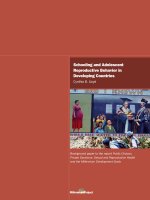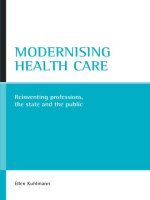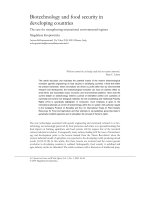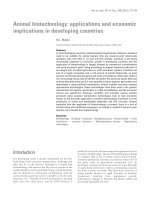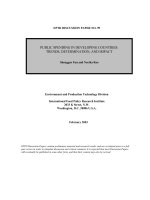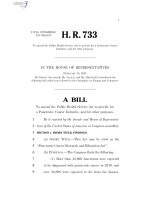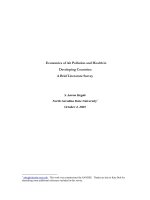Title: TRIPs, TRIPs-plus trend and the public health in developing countries
Bạn đang xem bản rút gọn của tài liệu. Xem và tải ngay bản đầy đủ của tài liệu tại đây (349.51 KB, 10 trang )
Title.
TRIPs, TRIPsplus trend and the public health in developing countries
Outline.
The right to health is one of the basic and essential human rights, which is provided in international
law as well as in national legislation (Article 25 of the United Nations' Universal Declaration of Human
Rights 1948 and Article 12 of the 1966 International Covenant on Economic, Social and Cultural
Rights). Implementing the right to health, which includes the right to access essential medicines, is
one of the core obligations of every state and of the whole international community.
The strong development of science and technology, especially in medical area, and the increase of
pharmaceutical patents have brought to human life many benefits in terms of enjoying the human right
to health. In that context, the TRIPs Agreement was adopted, which provides a mechanism for
protecting pharmaceutical patents. In principle, it helps promote the research and development
activities in medical field that can create more opportunities for human to have more new effective
medicines to prevent and/or cure illness. Simultaneously, such protection of pharmaceutical can have
negative impact on public health, as it can strict the medical access of human. Particularly, such
protection increases the price of medicine, which can be unaffordable to poor people, to developing
countries in some circumstances; and, if the patent’s holder abuses his right to have pharmaceutical
patent protected, he can harm to human right to health of others, by selling medicines with
unreasonably high price, or by asking inappropriate requirements for licensing…
In order to balance the interest of patent’s holder and society, as well as reduce the negative impact of
protecting pharmaceutical patents on human right to health, the TRIPs Agreement has provided for
some flexibilities and solutions, such as legal basis for parallel import and compulsory licensing…
Besides, the international community has also called for the action of ensuring human right to health in
the context of TRIPs, which can be seen via the Doha Declaration on the TRIPS agreement and public
health, and the WTO Decision on Implementation of Paragraph 6 of the Doha Declaration.
However, recently, a new trend in trade activities between states has been establishing, which is
known as the TRIPsplus trend. The TRIPsplus trend provides a higher level of protection on patents
in general and in pharmaceutical patent in particular, and also refuses many flexibilities provided in
TRIPs. Consequently, this trend creates more challenges to protecting public health as well as
ensuring the right to access medicines of human, especially in developing countries. Therefore, it calls
for concerns and consideration on the establishment of such TRIPsplus trend, in context of situation
of public health and medical access in developing countries. A prominent example of the TRIPsplus
trend, which is analyzed in this dissertation in order to clarify the trend of TRIPsplus, its nature and
1
impacts, is the TransPacific Partnership Agreement (TPP Agreement).
This dissertation aims to analyze the human right to health and critically analyze the protection
mechanism on pharmaceutical patents under the TRIPs and TRIPsplus trend in terms of affecting the
public health in general and in developing countries in particular.
Introduction
General overview and a brief history of the establishment of the TRIPs Agreement, the
relationship between protecting pharmaceutical patents under the TRIPs Agreement and the
medical access in general and in developing countries in particular, as well as the
establishment of the TRIPsplus trend (with the example of the TransPacific Partnership
Agreement TPP Agreement) and its new challenge towards protecting human right to health;
Research questions and aims of the dissertation;
Research methodology applied in the dissertation.
Chapter 1. The TRIPs Agreement and public health in developing countries (14p)
1.1
Overview on the TRIPs Agreement
Brief history and background of the establishment of the TRIPs Agreement
Aims and role of the TRIPs Agreement
Brief content of the TRIPs Agreement
1.2
Public health and medical access in developing countries
1.2.1 Overview on the human right to health and medical access (definition and role in ensuring
the development of human)
1.2.2 The reality of public health in developing countries
The reality of illness in developing countries and reasons (hunger, poverty, lack of
knowledge, environmental reasons, no access to preventing and/or curing medicines…)
The reality of medical access in developing countries, limitation and reasons (poverty,
lack of knowledge, stricted access to essential medicines due to protection of
pharmaceutical patents…)
1.3
The relationship of the TRIPs Agreement and public health
Overview on pharmaceutical patents: TRIPs Agreement covers all subjectmatters of IP
rights (copyright, industrial design, trademark…); but the subjectmatter that relates and
influences most on public health is patent, particularly pharmaceutical patent. It is the
2
first time that pharmaceutical products can be protected under patent system in global
level.
The protection of pharmaceutical patent under the TRIPs Agreement can promote the
medical development: creates more motivation for research and development in
pharmaceutical area, which leads to more new medicines that can help prevent and/or
cure new health diseases, and new medicines that are more effective…
The protection of pharmaceutical patent under the TRIPs Agreement can also strict
the medical access: such protection leads to higher price of medicines, which can be
unaffordable to developing countries, to poor people…; the abuse of such protection
of right holder can prevent developing countries from accessing to protected essential
medicines (due to unreasonable requirements for licensing those medicines…).
Chapter 2. Ensuring the public health in developing countries under the TRIPs (12p)
2.2.1 Solutions from TRIPs – Flexibilities
Parallel import: tackle with the negative impact of the TRIPs Agreement in creating high price
medicines
Compulsory license: prevent and tackle with the abuse of rights holder
Transition period for developing and least countries
Exceptions in protecting patent relating to public health (Article 27.2, 27.3, 30)
2.2.2 The Doha Declaration on the TRIPS agreement and public health 2001
2.2.3 The WTO Decision on Implementation of Paragraph 6 of the Doha Declaration on the
TRIPS Agreement and Public Health 2003
2.2.4 The Protocol amending the TRIPS Agreement 2005
Chapter 3. The TRIPsplus trend in the new context (14p)
3.1
The overview on TRIPsplus trend
Definition of TRIPsplus and reasons for its establishment
The recent development of TRIPsplus agreements
What are the differences between the TRIPs and TRIPsplus protection?: the TRIPs
plus trend provides a higher level of protection than the TRIPs Agreement; it also
refuses some flexibilities provided in TRIPs.
3.2 The TPP Agreement – prominent example of the TRIPsplus trend
What is the TPP Agreement?
3
The role of TPP Agreement (positive and negative impact)
The current status of TPP Agreement negotiation
Pharmaceutical patents protection under TPP Agreement
3.3 New challenges of the TRIPsplus trend and the TPP Agreement towards public health
Conclusion
4
Bibliography.
Books
1. Hestermeyer H, Human Rights and the WTO – The Case of Patents and Access to Medicines
(Oxford University Press 2007)
2. Ho C M, Access to Medicine in the Global Economy: International Agreements on Patents and
Related Rights (Oxford University Press 2011)
3. Scully A, ‘Human Rights, HIV and AIDS’ in Gearty C and Tomkins A (eds), Understanding
Human Rights (Pinter 1996)
4. Ssenyonjo M, Economic, Social and Cultural Rights in International Law (Hart Publishing
2009)
5. Connell P O, ‘The Human Right to Health in an Age of Market Hegemony’ in Harrington J and
Stuttaford M (eds), Global Health and Human Rights: Legal and Philosophical Perspectives
(reprint edn, Routledge 2012)
6. Meier B M, ‘The World Health Organization, the Evolution of Human Rights and the Failure to
Achieve Health for All’ in Harrington J and Stuttaford M (eds), Global Health and Human
Rights: Legal and Philosophical Perspectives (reprint edn, Routledge 2012)
7. Baxi U, ‘The Place of the Human Right to Health and Contemporary Approaches to Global
Justice: Some Impertinent Interrogations’ in Harrington J and Stuttaford M (eds), Global
Health and Human Rights: Legal and Philosophical Perspectives (reprint edn, Routledge
2012)
8. Cullet P, ‘Patents and Health in Developing Countries’ in Hatchard J and Kessaris A P (eds),
Law and Development: Facing Complexity in the 21st Century (Cavendish Publishing 2013)
9. Correa C M, Intellectual Property Rights, the WTO and Developing Countries – The TRIPs
Agreement and Policy Options (Zed Books 2000)
10. Cottier T, Trade and intellectual property protection in WTO LAW : Collected essays
(London:Cameron May 2005)
11. Helfer L R, ‘Mapping the Interface Between Human Rights and Intellectual Property’ in Geiger
C (ed), Research Handbook on Human Rights and Intellectual Property (Edward Elgar
Publishing Ltd 2015)
12. Wager H and Watal J, ‘Human Rights and International Intellectual Property Law’ in Geiger C
(ed), Research Handbook on Human Rights and Intellectual Property (Edward Elgar
Publishing Ltd 2015)
5
13. Seuba X, ‘Human Rights and Intellectual Property Law at the Bilateral and Multilateral Levels:
Substantive and Operational Aspects’ in Geiger C (ed), Research Handbook on Human
Rights and Intellectual Property (Edward Elgar Publishing Ltd 2015)
14. Correa C, ‘Mitigating the Impact of Intellectual Property in Developing Countries Through the
Implementation of Human Rights’ in Geiger C (ed), Research Handbook on Human Rights
and Intellectual Property (Edward Elgar Publishing Ltd 2015)
15. Matthews D, ‘Right to Health and Patents’ in Geiger C (ed), Research Handbook on Human
Rights and Intellectual Property (Edward Elgar Publishing Ltd 2015)
16. Shadlen K C and others, ‘Globalization, Intellectual Property Rights, and Pharmaceuticals:
Meeting the Challenges to Addressing Health Gaps in the New International Environment’ in
Shadlen K C and others (eds), Intellectual Property, Pharmaceuticals and Public Health:
Access to Drugs in Developing Countries (Edward Elgar Publishing Ltd 2013)
17. Klug H, ‘Pharmaceutical Production and Access to Essential Medicines in South Africa’ in
Shadlen K C and others (eds), Intellectual Property, Pharmaceuticals and Public Health:
Access to Drugs in Developing Countries (Edward Elgar Publishing Ltd 2013)
18. Krikorian G, ‘Intellectual Property and Access to Medicines: Paradoxes in Moroccan Policy’ in
Shadlen K C and others (eds), Intellectual Property, Pharmaceuticals and Public Health:
Access to Drugs in Developing Countries (Edward Elgar Publishing Ltd 2013)
19. Guzmán A, ‘The Challenges of Constructing Pharmaceutical Capabilities and Promoting
Access to Medicines in Mexico under TRIPS’ in Shadlen K C and others (eds), Intellectual
Property, Pharmaceuticals and Public Health: Access to Drugs in Developing Countries
(Edward Elgar Publishing Ltd 2013)
20. Flynn M, ‘Corporate Power and State Resistance: Brazil’s Use of TRIPS Flexibilities for its
National AIDS Program’ in Shadlen K C and others (eds), Intellectual Property,
Pharmaceuticals and Public Health: Access to Drugs in Developing Countries (Edward Elgar
Publishing Ltd 2013)
21. Shadlen K C, ‘The Politics of Patents and Drugs in Brazil and Mexico: The Industrial Bases of
Health Policies’ in Shadlen K C and others (eds), Intellectual Property, Pharmaceuticals and
Public Health: Access to Drugs in Developing Countries (Edward Elgar Publishing Ltd 2013)
22. Morin J F and Forcier M B, ‘Pharmaceutical Patent Policy in Developing Countries: Learning
from the Canadian Experience’, in Shadlen K C and others (eds), Intellectual Property,
Pharmaceuticals and Public Health: Access to Drugs in Developing Countries (Edward Elgar
Publishing Ltd 2013)
6
23. Lalitha N, ‘Access to Indian Generic Drugs: Emerging Issues’ in Shadlen K C and others
(eds), Intellectual Property, Pharmaceuticals and Public Health: Access to Drugs in
Developing Countries (Edward Elgar Publishing Ltd 2013)
24. Guennif S, ‘Access to Essential Drugs in Thailand: Intellectual Property Rights and Other
Institutional Matters Affecting Public Health in a Developing Country’ in Shadlen K C and
others (eds), Intellectual Property, Pharmaceuticals and Public Health: Access to Drugs in
Developing Countries (Edward Elgar Publishing Ltd 2013)
25. Aleman M M, ‘Impact of TRIPsPlus Obligations in Economic Partnership – and Free Trade
Agreements on International IP Law’ in Drexl J, RuseKhan H G and NaddePhlix S (eds), EU
Bilateral Trade Agreements and Intellectual Property: For Better or Worse? (Springer Berlin
Heidelberg 2014)
26. Musungu S F and Oh C, The Use of Flexibilities in TRIPs by Developing Countries: Can They
Promote Access to Medicines? (WHO, South Centre 2006)
27. ElSaid M K, Public Health Related TRIPsPlus Provisions in Bilateral Trade Agreements: A
Policy Guide for Negotiators and Implementers in the WHO Eastern Mediterranean Region
(WHO and ICTSD 2010)
28. Musungu S F and Dutfield G, Multilateral Agreements and A TRIPsPlus World: The World
Intellectual Property Organisation (WIPO) (QUNO and QIAP 2003)
29. Abbott F M, ‘Managing the Hydra: The Herculean Task of Ensuring Access to Essential
Medicines’ in Maskus K E and Reichman J H (eds), International Public Goods and Transfer
of Technology under a Globalised Intellectual Property System (Cambridge: Cambridge
University Press 2005)
Articles
1. Gleeson D, Lopert R and Reid P, ‘How the Trans Pacific Partnership Agreement could
undermine PHARMAC and threaten access to affordable medicines and health equity in New
Zealand’ [2013] 112 Health Policy 227
<cdn.com/S0168851013002108/1s2.0S0168851013002108main.pdf?_tid=0d818884
0eba11e58d5d00000aab0f01&acdnat=1433862975_500955ca0b26a0f3a80c4802ec87049a>
2. Ozdemir A, ‘TRIPs Agreement and Access to Essential Medicines’ [2008] 1 Ankara Bar
Review 90
3. Gupta A, ‘Patent Rights on Pharmaceutical Products and Affordable Drugs: Can TRIPs
Provide a Solution?’ [2004] 2 Buff. Intell. Pro. L.J. 127
7
4. Yu P K, ‘TPP and TransPacific Perplexities’ [2014] 37 Fordham Int'l L.J. 1129
5. Kilic B, ‘Defending the Spirit of the DOHA Declaration in Free Trade Agreements: Trans
Pacific Partnership and Access to Affordable Medicines’ [2014] 12 Loyola University Chicago
International Law Review 23
6. Silverman M E, ‘The Case for Flexible Intellectual Property Protections in the TransPacific
Partnership’ [2014] 27 Journal of Law and Health 215
7. Patel R, ‘A Public Health Imperative The Need for Meaningful Change in the TransPacific
Partnership's Intellectual Property Chapter’ [2015] 16 Minnesota Journal of Law, Science and
Technology 477
8. Lopert R and Gleeson D, ‘The High Price of Free Trade: U.S. Trade Agreements and Access
to Medicines’ [2013] 41 Journal of Law, Medicine and Ethics 199
9. MSF, ‘How the TransPacific Partnership Agreement Threatens Access to Medicines’,
Campaign for Access to Essential Medicines TPP Issue Brief (2011)
< />011.pdf>
10. Hoen E, ‘TRIPs, Pharmaceutical Patents, and Access to Essential Medicines: A Long Way
From Seattle to Doha’ [2002] 3 Chicago Journal of International Law 27
11. Correa C M, ‘TRIPs Agreement and Access to Drugs in Developing Countries’ [2005] 3 Sur
International Journal on Human Rights 25
12. Jusoh S, ‘Free Trade Agreements and Implications on Public Health – An Analysis of FTA of
Selected ASEAN Member States’ [2009] 4 Asian Journal of WTO & International Health Law
and Policy 187
13. Allums V, ‘Special 301: TRIPsPlus – Alive and Kicking’ [2006] 5 John Marshall Review of
Intellectual Property Law 651
14. Garnier O and others, ‘State Obligations to Guarantee the Human Right to Health and the
Derivative Right to Access Medicines’ [2012] 6 Health Law & Policy Brief 31
15. Pugatch M P, ‘The International Regulation of IPRs in a TRIPs and TRIPsPlus World’ [2005]
6 Journal of World Investment & Trade 431
16. Xiao P, ‘TRIPs Agreement and Public Health Crisis in Developing Countries: Problems and
Solutions’ [2009] 6 USChina Law Review 32
17. Forman L, ‘From TRIPsPlus to RightsPlus? Exploring Rights to Health Impact Assessment of
8
TradeRelated Intellectual Property Rights through the Thai Experience’ [2012] 7 Asian
Journal of WTO and International Health Law and Policy 347
18. Ranjan P, ‘Understanding the Conflicts between the TRIPs Agreement and the Human Right
to Health’ [2008] 9 Journal of World Investment & Trade 551
19. Hsu L, ‘Regulatory Flexibilities and Tensions in Public Health and Trade – An ASIAN
Perspective’ [2015] 10 Asian Journal of WTO and International Health Law and Policy 157
20. Attaran A, ‘The Doha Declaration on the TRIPs Agreement and Public Health, Access to
Pharmaceuticals, and Options Under WTO Law’ [2002] 12 Fordham Intellectual Property,
Media & Entertainment Law Journal 859
21. Sinai O T, ‘The TransPacific Partnership: Experimental Use of Patents on the International
Agenda’ [2014] 16 North Carolina Journal of Law & Technology 63
22. RuseKhan H G, ‘The International Law Relation between TRIPs and Subsequent TRIPsPlus
Free Trade Agreements: Towards Safeguarding TRIPs Flexibilities?’ [2011] 18 Journal of
Intellectual Property Law 325
23. Bucci C, ‘Responsible Patent Protections: Preserving Public Health Objectives in the Trans
Pacific Partnership Agreement’ [2013] 26 Pacific McGeorge Global Business & Development
Law Journal 213
24. CollinsChase C T, ‘The Case Against TRIPsPlus Protection in Developing Countries Facing
Aids Epidemics’ [2008] 29 University of Pennsylvania Journal of International Law 763
25. Baird S, ‘Magic and Hope: Relaxing TRIPsPlus Provisions to Promote Access to Affordable
Pharmaceuticals’ [2013] 33 Boston College Journal of Law and Social Justice 107
26. Chung L, ‘Use of Paragraph 6 System for Access to Medicine’ [2010] 36 North Carolina
Journal of International Law and Commercial Regulation 137
27. Morgan M R, ‘Medicines for the Developing World: Promoting Access and Innovation in the
PostTRIPs Environment’ [2006] 64 University of Toronto Faculty of Law Review 45
28. Saha S, ‘Patent Law and TRIPs: Compulsory Licensing of Patents and Pharmaceuticals’
[2009] 91 Journal of the Patent and Trademark Office Society 364
29. Nolff M, ‘Paragraph 6 of the Declaration on the TRIPs Agreement and Public Health and the
Decision of the WTO Regarding Its Implementation: An “Expeditious Solution”?’ [2004] 86
Journal of the Patent and Trademark Office Society 291
30. Kawharu A, ‘NOTE: The Negotiations for a TransPacific Partnership Agreement’ [2012] 27
ICSID Review 145
9
31. Sell S K, ‘TRIPsPlus Free Trade Agreements and Access to Medicines’ [2007] 28 Liverpool
Law Review 41
32. He J, ‘Developing countries’ Pursuit of an Intellectual Property Law Balance under the WTO
TRIPs Agreement’ [2011] Chinese Journal of International Law 827
33. ElSaid H and ElSaid M, ‘TRIPsPlus Implications for Access to Medicines in Developing
Countries: Lessons from JordanUnited States Free Trade Agreement’ [2007] 10 The Journal
of World Intellectual Property 438
34. Greenberg H and Shiau S, ‘The Vulnerability of Being Ill Informed: The TransPacific
Partnership Agreement and Global Public Health’ [2014] 36 Journal of Public Health 355
35. Kuanpoth J, ‘TRIPsPlus Intellectual Property Rules: Impact on Thailand’s Public Health’
[2006] 9 The Journal of World Intellectual Property 573
36. CohenKohler J C, Forman L and Lipkus N, ‘Addressing Legal and Political Barriers to Global
Pharmaceutical Access: Options for Remedying the Impact of the Agreement on Trade
Related Aspects of Intellectual Property Rights (TRIPs) and the Imposition of TRIPsPlus
Standards’ [2008] 3 Health Economics, Policy and Law 229
37. Löfgren H, ‘The TransPacific Partnership Agreement: A Threat to Affordable Medicines and
Public Health’ [2011] 4 Southern Med Review 49
38. Bernieri R C, ‘Compulsory Licensing and Public Health: TRIPsPlus Standards in Invesment
Agreements’ [2009] 2 Transnational Dispute Management Journal
39. Xiong P, ‘Patents in TRIPsPlus Provisions and the Approaches to Interpretation of Free
Trade Agreements and TRIPs: Do They Affect Public Health?’ [2012] 46 Journal of World
Trade 155
40. Lindstrom B, ‘Scaling Back TRIPsPlus: An Analysis of Intellectual Property Provisions in
Trade Agreements and Implications for Asia and The Pacific’ [2010] 42 New York University
Journal of International Law and Politics 917
10

